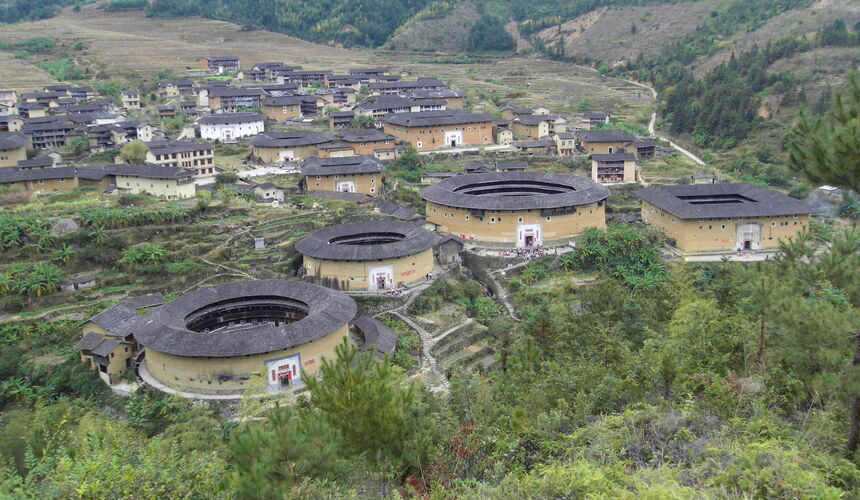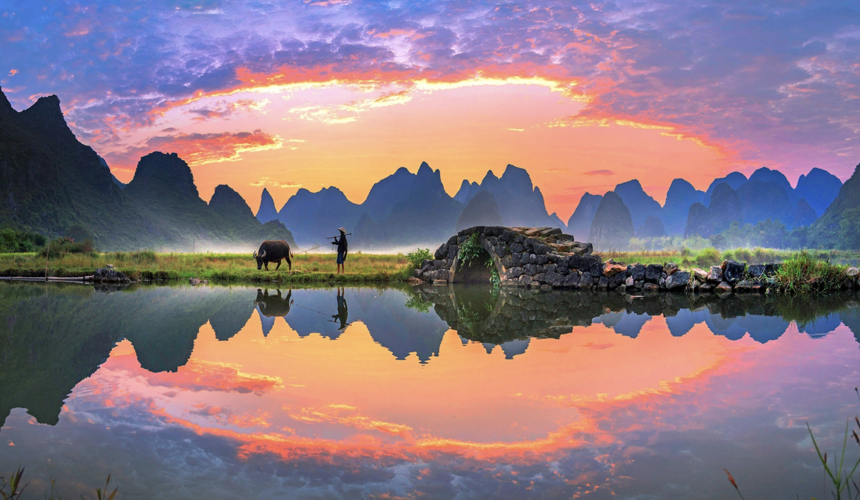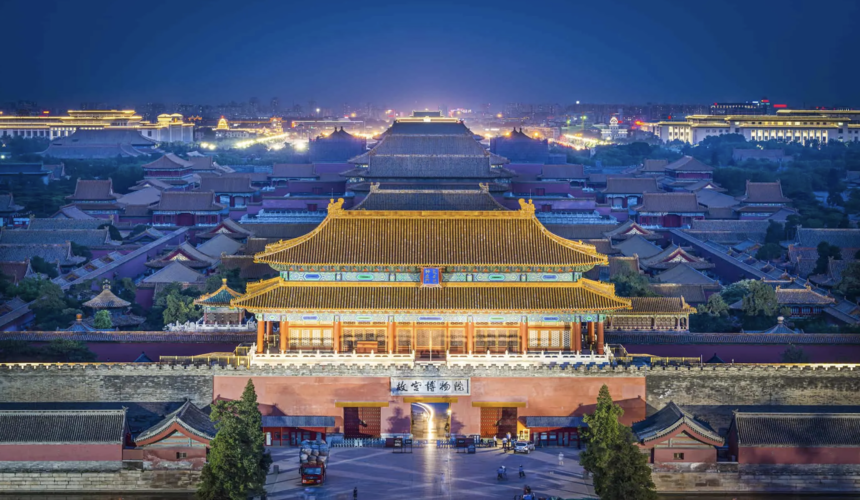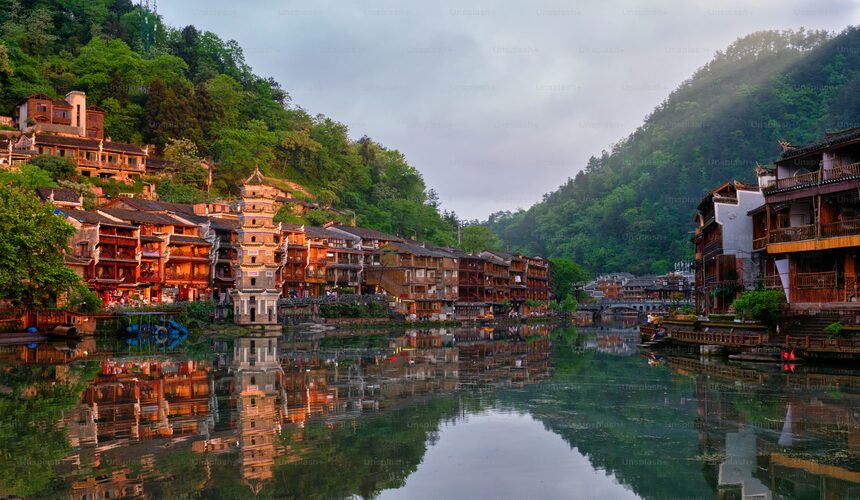
16 Unique Destinations in China Away from the Crowds
China is home to some of the world’s most famous landmarks, from the Great Wall to the Terracotta Army. But beyond these iconic attractions lies a different side of the country waiting to be explored. If you’re looking to escape the busy tourist routes, this guide to unique destinations in China will take you off the beaten path.
From misty mountain villages and tranquil lakes to ancient towns untouched by mass tourism, these hidden gems in China offer a more authentic glimpse into its vast beauty and diverse culture. Whether you’re an adventurer or traveler seeking authenticity, these 16 unique destinations in China away from the crowds will inspire you to see a whole new perspective about this vast land.
1. Ruyi Peak Scenic Spot (Yangshuo County, Guangxi)
Hidden amid the lush karst mountains of Yangshuo County, Ruyi Peak Scenic Spot is a rising gem that showcases some of southern China’s most surreal landscapes. A glass-bottom bridge suspended between towering peaks offers breathtaking views of misty limestone mountains, emerald rice paddies, and winding rivers. A scene that feels straight out of a traditional Chinese painting. Although it’s gaining attention on Chinese social media, Ruyi Peak remains relatively off the beaten path, making it an ideal escape for travelers seeking spectacular scenery without the heavy crowds.
- Best Time to Visit: Spring (March–May) and Autumn (September–November) for clear skies, mild temperatures, and vibrant colors. Avoid major Chinese holidays when domestic tourism peaks.
- Famous For: Glass-bottom bridge suspended over dramatic karst cliffs. Panoramic sunrise and sunset viewpoints.
- Travel Tips: Arrive early for softer light and fewer crowds. Wear sturdy shoes if you plan to explore beyond the paved areas. The scenic spot is best accessed by private car from Yangshuo or Guilin.

2. Furong Ancient Town (Hunan Province)
Perched dramatically on a cliffside above a cascading waterfall, Furong Ancient Town is a hidden gem where Tujia minority culture meets breathtaking natural beauty. Once a filming location for a famous Chinese movie, this centuries-old village has somehow remained off the radar for most foreign travelers. Wander through cobbled alleys, admire the stilted wooden houses that cling to the cliffs, and take in panoramic riverside views that glow beautifully at sunset. By night, the town transforms into a romantic scene of lantern-lit bridges and reflections dancing on the water. A timeless picture of old China.
- Best Time to Visit: Spring and Autumn offer pleasant weather and fewer tourists. Visit in Summer if you want to see the waterfall at its most powerful.
- Famous For: Cliffside stilt houses overlooking a massive waterfall, rich Tujia ethnic heritage, traditional crafts, and enchanting nighttime performances.
- Travel Tips: Pair your visit with a trip to Zhangjiajie National Forest Park, located about two hours away. Don’t miss local delicacies like Tujia sour fish soup and homemade rice wine. Bring cash, as some shops may not accept foreign cards or digital payments like WeChat Pay.
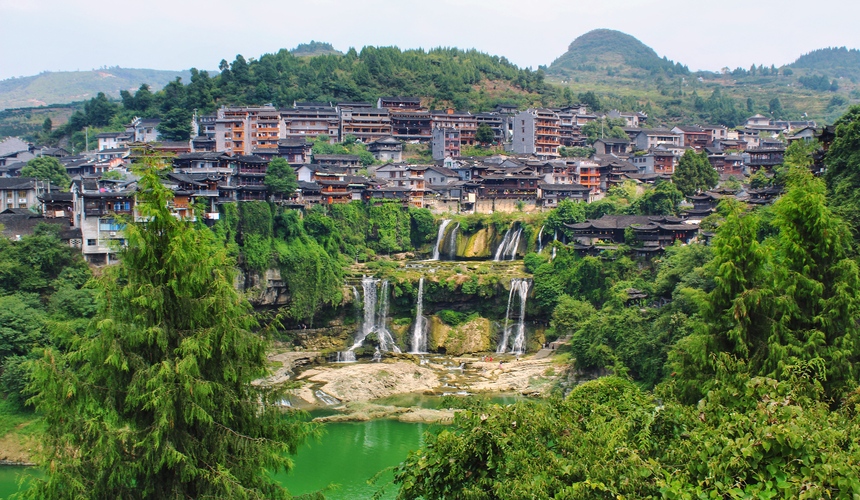
3. Wanfenglin Scenic Area (Guizhou Province)
Stretching endlessly like a sea of jagged karst hills, Wanfenglin Scenic Area near Xingyi City, Guizhou Province, offers some of China’s most breathtaking landscapes. Not as many crowds as in Guilin or Zhangjiajie. This hidden gem embodies the untamed beauty of southern China, perfect for travelers seeking off-the-beaten-path adventures. From above, the karst peaks rise dramatically like green towers, while below, quiet farmland and winding rivers paint a scene. It’s a paradise for photographers, cyclists, and anyone looking to soak in nature at a slower pace.
- Best Time to Visit: April to October, when the fields and terraces are lush and green. Early summer is ideal to catch the golden rapeseed flowers in full bloom.
- Famous For: Vast karst mountain fields, especially stunning from viewpoints. Peaceful cycling through scenic countryside and untouched rural landscapes.
- Travel Tips: Rent a bike or electric scooter to explore the winding roads at your own pace. Avoid the midday sun; mornings and evenings offer cooler temperatures and more photogenic light.
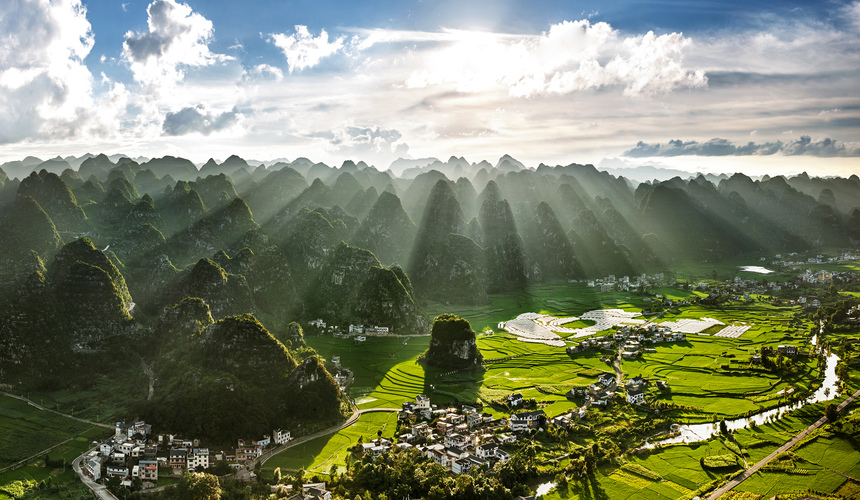
4. Puzhehei Scenic Resort (Yunnan Province)
A fairytale landscape of emerald lakes, dramatic karst hills, blooming lotus fields, and charming Yi minority villages. Puzhehei Scenic Resort is one of Yunnan’s most serene hidden gems. Unlike the more tourist-heavy Guilin or Yangshuo, Puzhehei remains relatively untouched. Make it a perfect destination for travelers seeking off-the-beaten-path experiences. Glide along tranquil waters framed by towering karst peaks, explore colorful Yi villages, or simply watch the sunset paint the wetlands in golden hues. It’s a photographer’s dream and a true escape into nature.
- Best Time to Visit: June to August, when the lotus flowers are in full bloom and the landscape is at its most enchanting.
- Famous For: Scenic boat rides through lotus-filled lakes, vibrant Yi minority festivals, and breathtaking sunsets over the wetlands.
- Travel Tips: Rent a small boat for a quiet paddle among the lotus fields. Don’t miss the local Yi cuisine, particularly grilled fish and sticky rice for an authentic taste of the region.
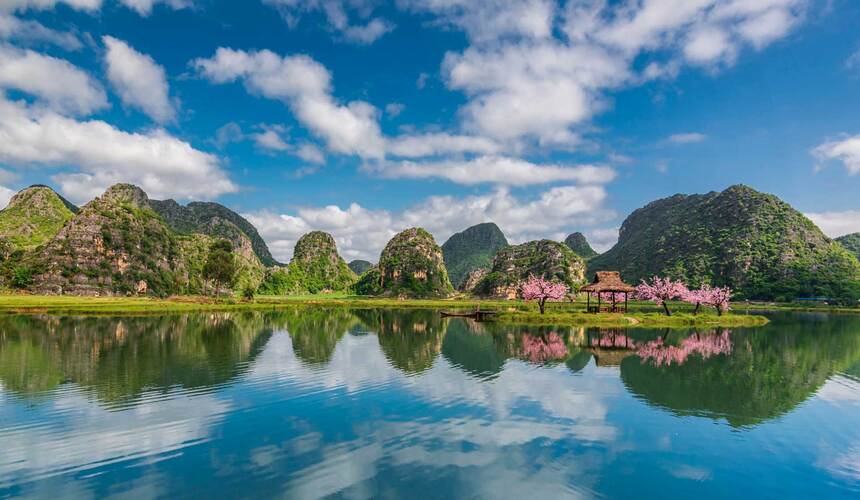
5. Mount Qingcheng (Sichuan Province)
Renowned as one of the cradles of Taoism in China, Mount Qingcheng is a serene retreat of misty peaks and centuries-old temples nestled into the mountainside. While nearby Mount Emei draws larger crowds, Qingcheng offers a more spiritual experience, making it an ideal choice for travelers seeking a reflective journey into China’s Taoist heritage. Wander through bamboo forests, follow moss-covered paths, and explore temples that have stood for centuries. The combination of natural beauty and spiritual history makes every step a journey into calm and contemplation.
- Best Time to Visit: Spring (March–May) and Autumn (September–November) for clear skies and fewer crowds. Summer brings lush greenery but can be hot and humid.
- Famous For: Taoist temples, spiritual hiking trails, bamboo forests, moss-covered pathways, and scenic cable car or boat options for exploring the mountains.
- Travel Tips: Visit Front Mountain for temple-focused with spiritual experiences and Back Mountain for more rugged hiking. Pair your trip with a visit to the nearby Dujiangyan Irrigation System, a UNESCO World Heritage Site.
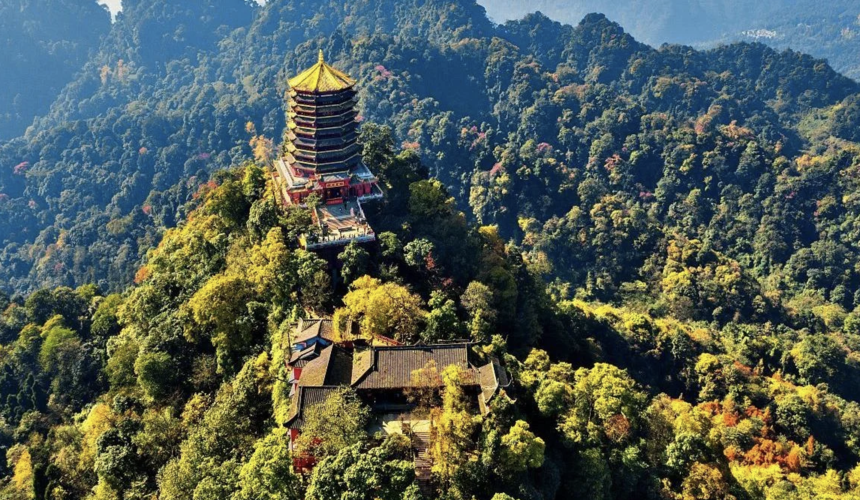
6. Kashgar’s Old Town (Xinjiang Uygur Autonomous Region)
At the far western edge of China lies Kashgar, a legendary Silk Road city that feels like stepping straight into Central Asia. Its Old Town is a maze of winding alleys, mud-brick homes, and colorful bazaars. It can offer you an authentic glimpse into a mix of Uyghur culture, Islamic architecture, and nomadic history. A visit here is like entering a living museum where every street corner tells a story. The atmosphere is vibrant and immersive, especially during the bustling Sunday Bazaar, where spices, textiles, and local crafts fill the air with color and aroma. Sampling the rich Uyghur cuisine is a must, such as hand-pulled noodles, roasted lamb skewers, and sweet pastries.
- Best Time to Visit: Spring (April–June) and Autumn (September–October) for comfortable temperatures and clear skies.
- Famous For: The lively Sunday Bazaar, centuries-old Uyghur architecture, and a rich tapestry of cultural traditions.
- Travel Tips: Dress conservatively to respect local customs in this majority-Muslim region. Photography is welcome, but always ask permission before taking portraits of locals.
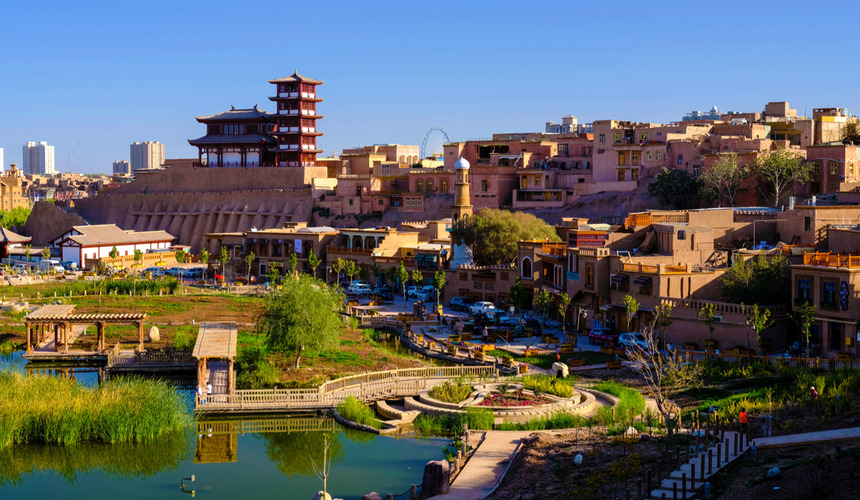
7. Wulong Karst Geological Park (Chongqing Municipality)
Wulong Karst Geological Park is a UNESCO World Heritage site. Here is the dramatic showcase of limestone formations, featuring towering natural bridges, deep sinkholes, and mysterious caves. Though it has gained cinematic fame from films like Transformers: Age of Extinction, it remains a relatively unexplored gem for travelers seeking awe-inspiring natural wonders. The park’s most iconic feature is the Three Natural Bridges, a series of colossal limestone arches set within a lush gorge. Beneath the surface, vast underground caves like Furong Cave reveal intricate stalactites and subterranean beauty that feels almost otherworldly.
- Best Time to Visit: April to October, when the weather is pleasant and the landscapes are vibrant and green.
- Famous For: Three Natural Bridges, Furong Cave, and other striking karst formations.
- Travel Tips: Access Wulong from Chongqing (2–3 hours by car or train). Wear comfortable shoes, as the terrain involves a lot of walking and stairs. The park is extensive, so plan at least two days to explore fully and soak in all its natural wonders.
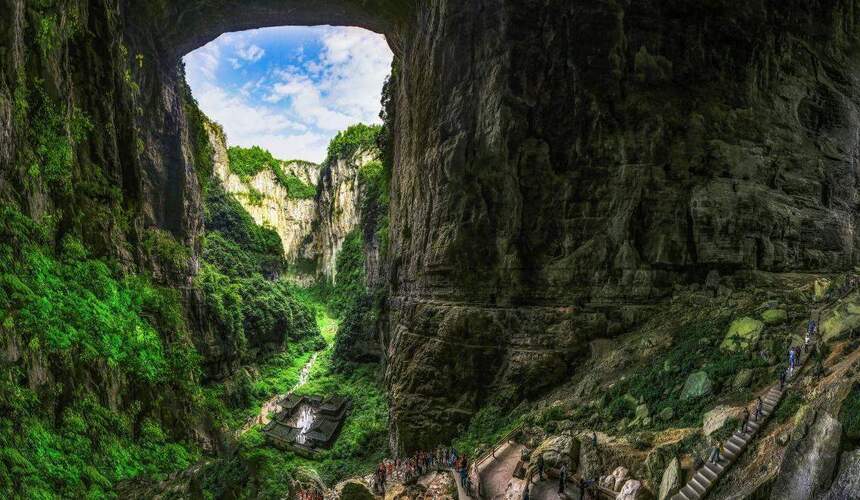
8. Hanging Temple (Datong City, Shanxi Province)
Perched 75 meters above the ground on a sheer cliff face, the Hanging Temple is an architectural marvel that has stood for over 1,500 years. Unlike any other temple in China, it uniquely combines Buddhism, Taoism, and Confucianism, all supported on wooden stilts. It is a daring design that has captivated visitors for centuries. Its dramatic cliffside location and spiritual significance make it one of China’s most intriguing off-the-beaten-path attractions. Explore narrow walkways and steep staircases that wind through this extraordinary structure. Marvel at the ingenuity of ancient builders who defied gravity and time.
- Best Time to Visit: Spring (April–June) and Autumn (September–October) for mild weather and clear skies. Avoid winter due to icy cliffs and summer for high heat.
- Famous For: Precariously perched cliffside architecture and the unique fusion of three major religions.
- Travel Tips: Wear sturdy, comfortable shoes for climbing and walking along narrow paths. Pair your visit with the nearby Yungang Grottoes, another UNESCO World Heritage Site in Datong.
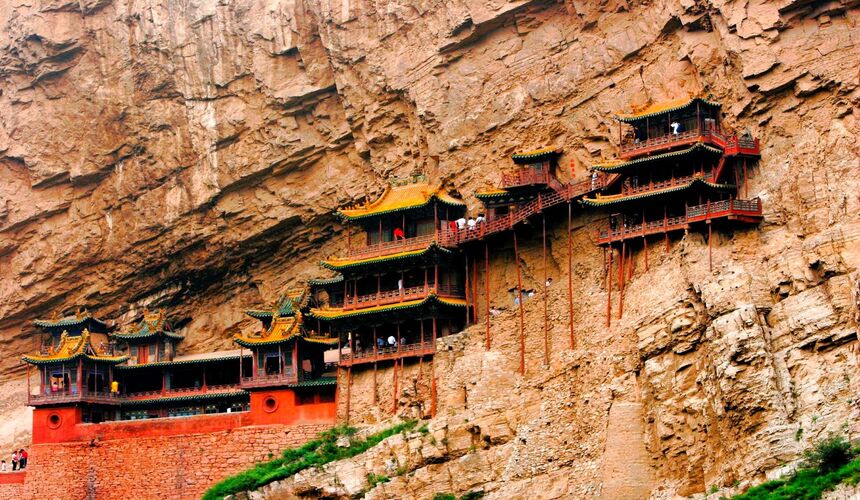
9. Mount Fanjing (Guizhou Province)
Rising sharply from the Wuling Mountain range, Mount Fanjing is a mystical peak and UNESCO World Heritage site celebrated for its otherworldly landscapes. Famous for its “Mushroom Rock” formations, cliffside Buddhist temples, and rich biodiversity. Fanjing offers a serene escape for nature lovers and spiritual seekers. With stunning alpine scenery and peaceful hiking trails, it’s one of China’s most unexplored and rewarding destinations. Take in the panoramic views of misty peaks. Explore ancient temples perched on precarious cliffs. Encounter diverse flora and fauna that make this mountain a living sanctuary.
- Best Time to Visit: Spring (April–June) and Autumn (September–November) for pleasant weather and colorful foliage.
- Famous For: The iconic Mushroom Rock formations, ancient cliffside Buddhist temples, and abundant biodiversity.
- Travel Tips: Prepare for strenuous hiking, as some trails are steep but rewarding. Use the cable car to conserve energy for temple visits and viewpoints. Pack warm clothing, as temperatures can drop quickly at high altitudes.
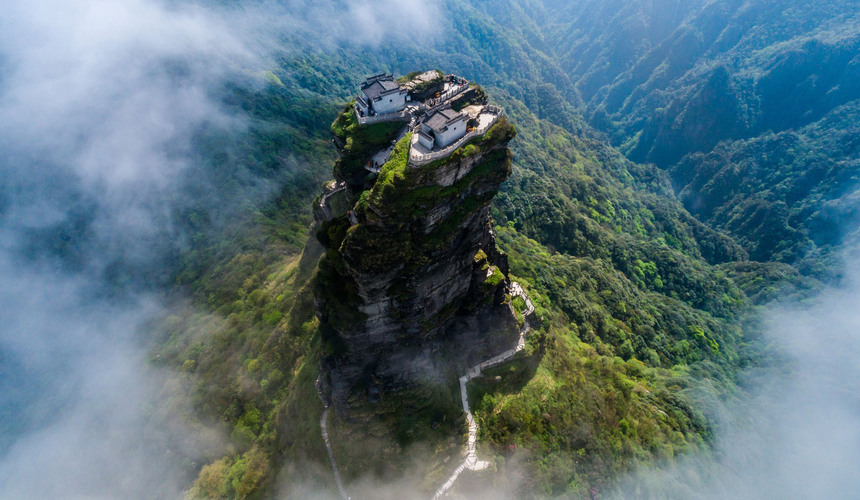
10. Detian Waterfall (Chongzuo City, Guangxi Province)
Straddling the border between China and Vietnam, Detian Waterfall is one of Asia’s largest transnational waterfalls. Set against a backdrop of lush karst mountains and vibrant forests. Despite its spectacular scale, it remains relatively off the beaten path. Make it a hidden gem for travelers seeking dramatic natural scenery. Marvel at the multi-tiered cascades plunging over limestone cliffs, enjoy cross-border views, and explore scenic hiking trails or boat rides that bring you close to the thundering waters. The roar of the falls and the surrounding greenery make for a truly unforgettable experience.
- Best Time to Visit: May to October during the rainy season for the fullest, most dramatic waterfall flow. The dry season offers easier hiking but reduced water volume.
- Famous For: Impressive multi-tiered waterfall, cross-border vistas, and scenic boat rides and hiking trails.
- Travel Tips: Wear waterproof shoes or sandals, as trails can be slippery. Pair your visit with the nearby Mingshi Scenic Area. Be prepared for hiking and stairs to reach the best viewpoints.
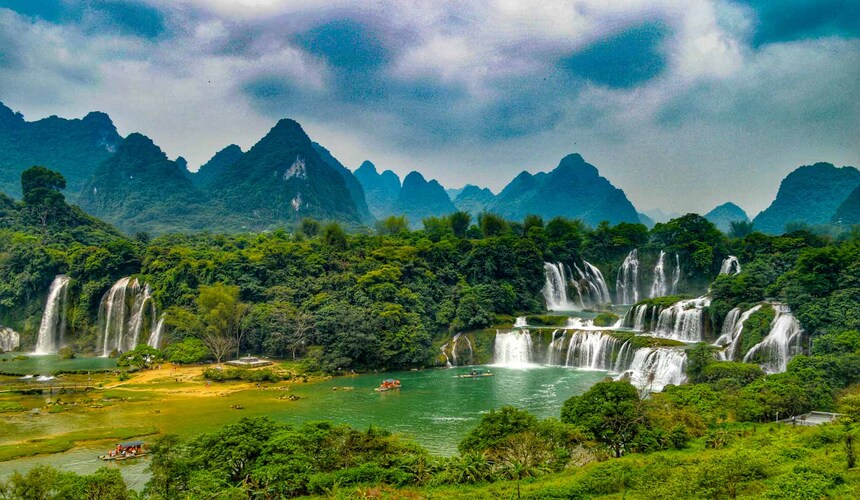
11. Tulou Clusters (Fujian Province)
Scattered throughout rural Fujian, the Tulou Clusters are massive circular or square earthen buildings built by the Hakka people as communal living fortresses. These UNESCO World Heritage sites are architectural marvels with centuries of history, offering you a rare glimpse into traditional Hakka culture and rural life. While some Tulou villages are well-known, many remain peaceful and largely untouched by mass tourism. Step inside these incredible structures to explore communal courtyards, sturdy defensive walls, and centuries-old craftsmanship that has stood the test of time. Staying overnight in a renovated Tulou provides a truly immersive experience.
- Best Time to Visit: Spring (March–May) and Autumn (September–November) for pleasant weather and local festivals. Avoid the rainy season (June–August).
- Famous For: Unique earthen architecture designed for defense and communal living, and rich Hakka culture and traditions.
- Travel Tips: Hire a local guide to fully appreciate the history and significance of each Tulou. Stay overnight in a renovated Tulou guesthouse for a unique experience. Bring cash, as some remote villages may have limited payment options.
12. Badain Jaran Desert (Inner Mongolia)
The Badain Jaran Desert is one of China’s largest and most mysterious deserts. Famed for its towering sand dunes and some soaring over 500 meters high. Scattered throughout this vast sandy expanse are hidden spring-fed lakes, creating surreal oasis landscapes rarely seen by travelers. It’s a true off-the-beaten-path adventure, perfect for desert explorers and those seeking untouched natural beauty. Experience the dunes’ “singing” sands, ride camels across endless waves of sand, and marvel at the oasis lakes glimmering in the sun. At night, the desert sky transforms into a stunning canvas of stars, offering unforgettable stargazing opportunities.
- Best Time to Visit: May to September for milder temperatures and clear skies. Avoid winter due to extreme cold and snow.
- Famous For: Massive singing sand dunes, hidden desert lakes and springs, camel treks, and unparalleled stargazing.
- Travel Tips: Join a guided tour with experienced desert drivers or camel herders. Cell service is limited, so prepare accordingly and carry sufficient water and supplies.
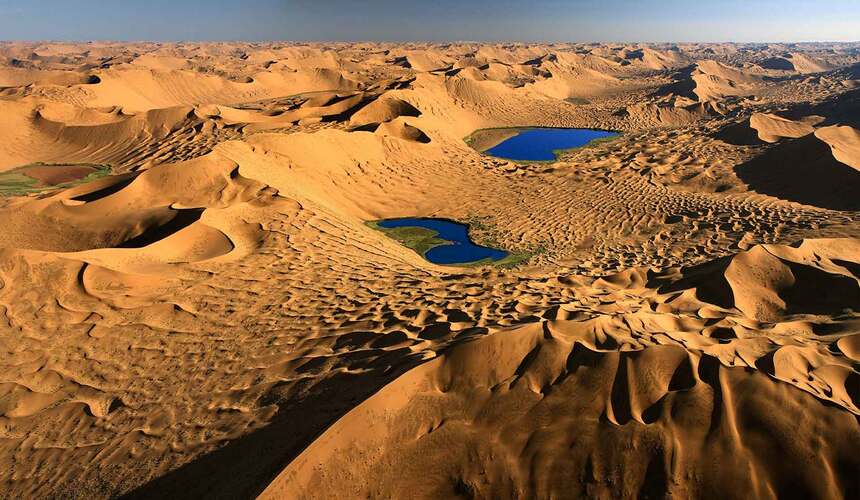
13. Kaiping Diaolou (Guangdong Province)
The Kaiping Diaolou are distinctive multi-story fortified towers built by returning Chinese emigrants in the early 20th century. These UNESCO-listed structures uniquely combine Chinese and Western architectural styles. It is historically designed for protection against bandits and flooding. While some towers have gained popularity, many villages remain peaceful. Offer you a rare glimpse into alternative China travel and rural life. Wander through scenic countryside dotted with these striking towers, each telling a story of history, migration, and cultural fusion. Staying overnight in a local guesthouse adds an authentic touch to the experience.
- Best Time to Visit: October to March for cooler, drier weather.
- Famous For: Unique fusion of Chinese and Western architecture and picturesque rural landscapes featuring diaolou towers.
- Travel Tips: Rent a bike or scooter to explore multiple diaolou villages at your own pace. Stay overnight in a local guesthouse for a more immersive experience.

14. Dongchuan Red Land (Yunnan Province)
Dongchuan Red Land is a breathtaking patchwork of crimson soil, rolling hills, and terraced farms in Yunnan. The striking contrast of red earth and green crops creates one of China’s most vivid and lesser-known landscapes. It’s a must-see for photographers and those craving an unexplored destination in China. Wander through terraced fields that change hues with the seasons, capture the dramatic rural scenery, and experience the charm of local farming life against a backdrop of vibrant colors.
- Best Time to Visit: September to November, when the soil is most vividly red and crops are ready for harvest.
- Famous For: Spectacular red soil landscapes, terraced fields, and authentic rural farming scenes.
- Travel Tips: Rent a car or hire a local driver for the easiest access. Stay in nearby Luoxi Village for convenience and local accommodation options.

15. Hemu Village (Xinjiang Uygur Autonomous Region)
Hemu Village nestled in the Altay Mountains, is a charming wooden hamlet home to Kazakh herders. Surrounded by lush meadows and towering peaks, it offers a rare glimpse into traditional nomadic life. Since it is far away in Xinjiang threfore make it one of China’s most hidden and idyllic travel spots. Here, the landscapes evoke a sense of serenity far from urban bustle. Stroll past wooden cabins and yurts, interact with locals to learn about Kazakh traditions. Or ride horseback through the rolling meadows while enjoying panoramic views of northern Xinjiang’s majestic mountains.
- Best Time to Visit: Summer (June–August) for vibrant greenery and mild weather, or early autumn for golden meadows and harvest festivals.
- Famous For: Traditional wooden cabins and yurts, rich Kazakh culture, and horseback riding through scenic meadows.
- Travel Tips: Book accommodations in advance, as options are limited during peak season. Bring insect repellent for summer visits, and always respect local customs, asking permission before photographing residents.
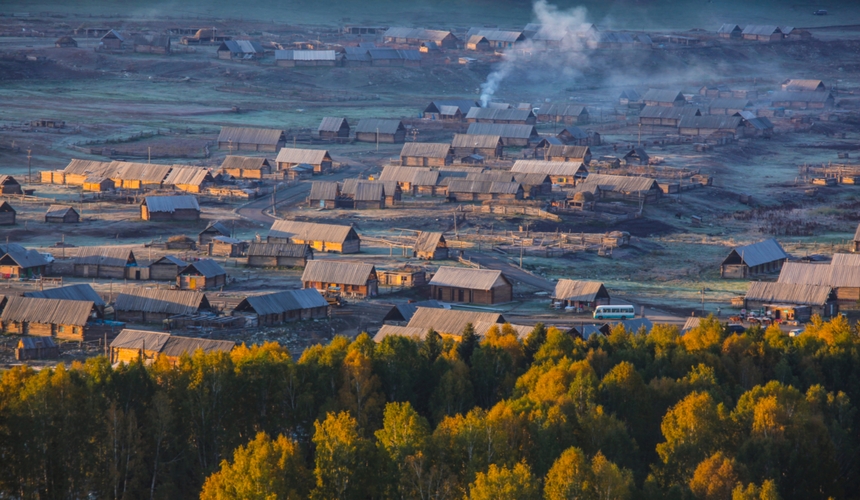
16. Bingzhongluo Scenic Area (Nujiang Prefecture, Yunnan Province)
Nestled deep in the remote Nujiang Grand Canyon, Bingzhongluo Scenic Area is a hidden gem. You can find dramatic river bends, lush mountains, and traditional ethnic villages that create a breathtaking landscape. The area is famous for the “First Bend” of the Nujiang River, a striking U-shaped turn framed by steep cliffs and verdant valleys. It’s a perfect destination for travelers seeking off-the-beaten-path scenery and authentic minority culture. Stroll through riverside villages, experience local life, and take in panoramic views of the surrounding mountains and gorges. The scenery here is dramatic yet tranquil, far removed from the crowds found at more famous tourist spots in Yunnan.
- Best Time to Visit: Late spring through summer, when the vegetation is lush and the skies are clear.
- Famous For: The First Bend of the Nujiang River, panoramic canyon vistas, and traditional ethnic minority villages.
- Travel Tips: Access can be challenging, so plan for longer travel times and limited services. Bring cash and basic supplies, as amenities are sparse. Hiring a local guide can enhance your experience and provide cultural insights.
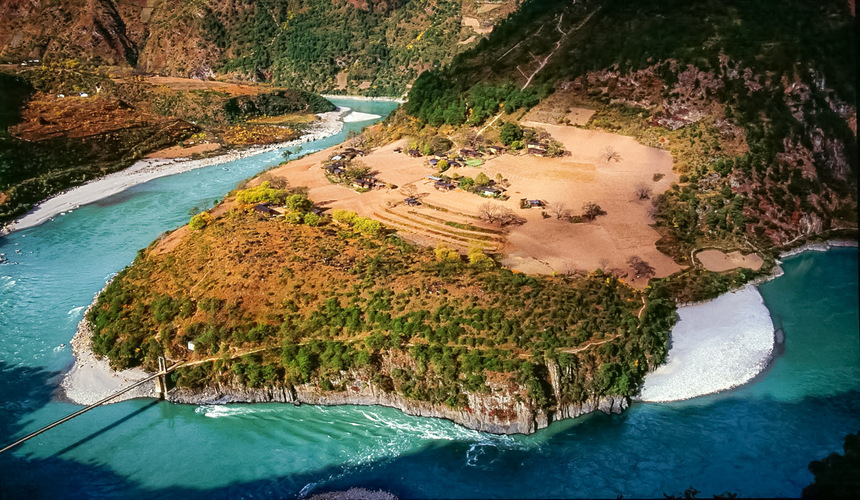
For personalized travel advice, itinerary planning, or booking assistance, contact [email protected] or reach us via WhatsApp: +86 187 2197 8867. Ready to create a travel story that’s uniquely yours? Let China surprise you, one secret spot at a time.


